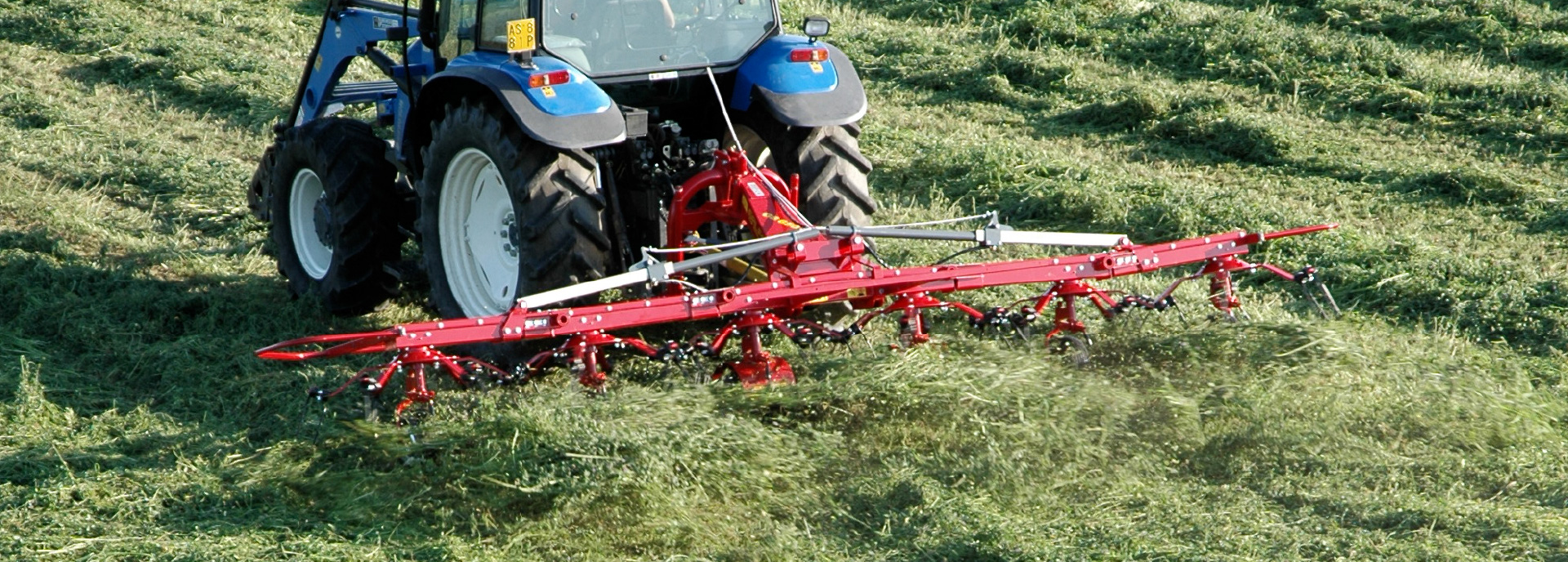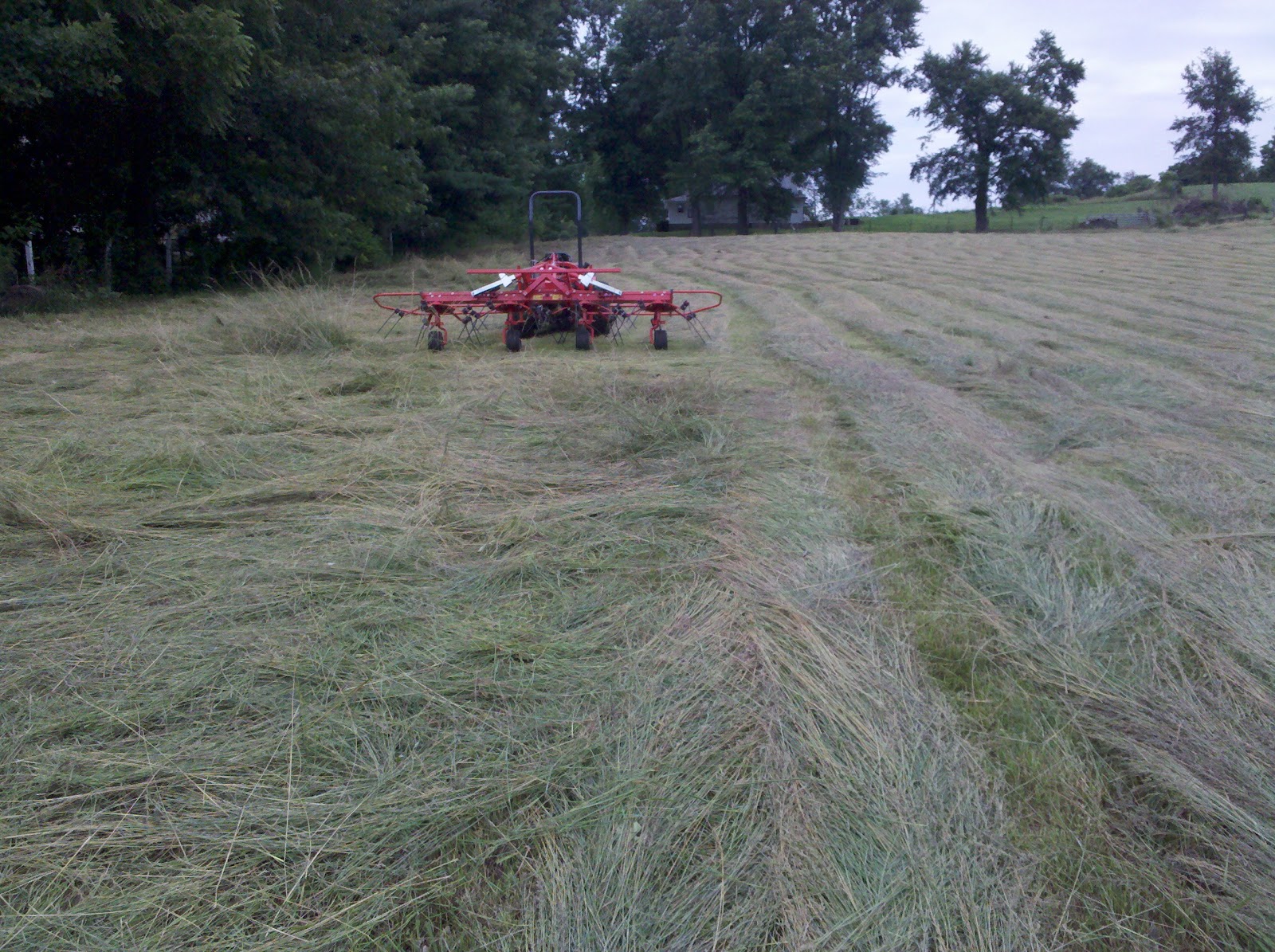Drying Your Hay - Tedding Tips

April’s blog discussed the first step of the baling process--mowing. This month’s blog will give tips for the next step--tedding.
What is a tedder?
A tedder is an implement that is used to fluff and spread hay to decrease drying time. Tedding is typically done after the hay is mowed and before it is raked into windrows for baling. Many hay mowers, unless they have a built-in conditioning system like our Ibex TS51C and TM67C drum mowers, tend to windrow the cut crop into a tight pile that does not dry well. Tedding breaks up these piles and exposes the hay on the underside of a pile to air and sunlight, speeding up the drying process. Most tedders use a rotary motion to grab the hay with spinning tines and cast it out the back of the machine.
Under what conditions should I ted?
Considering the climate of your area is recommended when deciding if a tedder is right for your operation. Heavy hay in humid climates can dry faster by tedding. It is also an indispensable machine for spreading hay out to dry after a rain. Although some farmers in more arid climates get by without a tedder, it is smart to have a machine that can do this important job when the need arises.

Knowing when to ted is also important. A tedder should be used only when the crop is moist enough not to lose leaves in the process. This is especially true for leafy type crops like alfalfa and clover. Unfortunately, tedding when too dry can result in the loss of the most nutritious parts of the plant. Tedding is recommended after surprise rain storms or heavy dews. It might even be necessary to ted multiple times depending upon drying conditions.
In drier climates, when you have lighter cuttings, or if you have a mower that spreads the forage out as it is cut, you may not need to use a tedder. Keep in mind, as well, that if you have a belt rake or rotary rake, you can rake the hay before it is completely dry. The hay will finish drying in the tall, fluffy windrows created by these rakes.
Do I need a tedder or will a rake do the job?
Some hay rakes will double as tedders, to varying degrees of success. Wheel rakes can flip a windrow over or can agitate hay that is spread in the field, but they tend to leave clumps of hay that don’t dry well. Some machines are specifically built to convert between raking and tedding. However, most take a great deal of work to switch from one to the other, costing you valuable time, usually when you don’t have it.
However, one rake that is perfectly designed for use as a tedder is the belt rake. Switching from rake to tedder with this implement, such as one from our Ibex line, only takes a few seconds and does not require tools. Furthermore, this machine truly spreads the hay evenly as a tedder should. With its compact design, it is great for work in the tight spaces commonly found on smaller farms. Since it replaces two implements with one, a belt rake saves room in the barn and saves money in your pocketbook!
How do I ted?
The path you take through the field when tedding is not really critical. If you have long, straight sections of the field, you may find that you can follow the same path as the mower and ted two, three, or even four rows of cut hay in one pass. Since a tedder is generally much wider than a mower though, it may not make sense to try to follow the exact path of the mower. It may make more sense to wind generally from the outside of the field to the inside, or go back and forth and finish with the edges.
Other factors to consider:
In what situations is tedding needed?

- To spread and fluff the hay soon after cutting. This allows for better air circulation and more exposure to sunlight. Most small hay mowers will lay the hay down flat like toppled dominoes. This does not create optimal drying conditions. Most drum mowers also pile the hay in rows, meaning air and sunlight can’t reach the bottom of the pile.
- After a heavy rain. When it rains enough to saturate all the way through the cut hay, you will need to wait for a period of time to let the sun dry out the top of the hay, and then take a tedder through the field to flip the hay over so the underside can get dry.
- In areas that receive less sun or breeze. You may find that the middle of a field is dry and ready to bale, while the edges and areas in alcoves are not. This is due to the reduced sun and airflow in these areas. In these cases you don’t need to ted the whole field, just the areas that need a little extra “help”.
- In cooler, more humid, and cloudy weather. In this situation, you may find that hay near the ground just will not get dry without some help.
When should I ted?
- Soon after cutting.
- In the morning while there is still some dew on the ground. Dewy conditions will soften leaves that are already dry, reducing leaf loss when tedding.
- A few dry hours after a rain.
Again, you should only use a tedder when the hay won’t be able to get dry on its own. Overuse of the tedder will lead to stemmy, low quality hay.
In conclusion, tedding may be necessary when you want quality hay and a speedy production process. Tedding speeds drying and dissipates heat, sealing in nutrients as the hay cures. It ensures that mold and bacteria do not develop. Including this step in the haying process can prevent the many problems caused by overly damp hay like dangerous mold growth, loss of edible forage, and even barn fires.
Maybe it's time to add a tedder to your inventory of hay equipment. If so, check out our website ( tractortoolsdirect.com) or give us a call today (260-BALE-HAY) to learn more about our 2-in-1 raking and tedding machine--the Ibex Belt Rake.
Recent Posts
-
Yes! Cutting Height Matters in Haymaking
When it comes to haymaking, one of the most crucial decisions a farmer or producer must ma …Jul 1st 2025 -
Weather Watchers: The Role of Weather in Haymaking
When it comes to producing high-quality hay, few factors are more critical—or more u …Jun 24th 2025 -
Small Farm Success: The Case for DIY Hay Production
At Tractor Tools Direct, we are committed to helping small farm operations achieve haying …Jun 16th 2025




